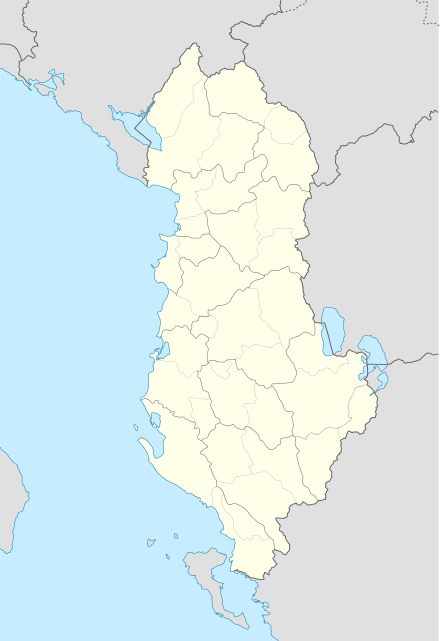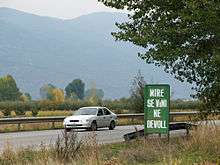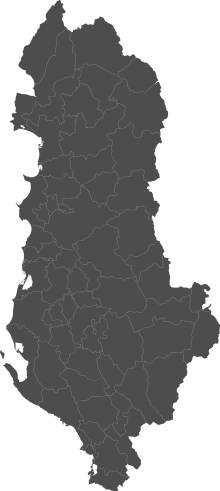Devoll (municipality)
| Devoll | ||
|---|---|---|
| Municipality | ||
| ||
 Devoll | ||
| Coordinates: 40°38′N 20°59′E / 40.633°N 20.983°E | ||
| Country |
| |
| County |
| |
| Government | ||
| • Mayor | Bledjon Nallbati (PD) | |
| Area | ||
| • Municipality | 453.27 km2 (175.01 sq mi) | |
| Population (2011) | ||
| • Municipality | 26,716 | |
| • Municipality density | 59/km2 (150/sq mi) | |
| Time zone | UTC+1 (CET) | |
| • Summer (DST) | UTC+2 (CEST) | |
| Postal Code | 7006 | |
| Area Code | (0)811 | |
| Vehicle registration | AL | |
| Website | official%20website | |
Devoll (definite Albanian form: Devolli) is a municipality in Korçë County, southeastern Albania. It was created in 2015 by the merger of the former municipalities Bilisht, Hoçisht, Miras, Progër and Qendër Bilisht. The seat of the municipality is the town Bilisht.[1] The total population is 26,716 (2011 census), in a total area of 453.27 km2.[2] It derives its name from the Devoll river flowing through the valley. It had a population of 33,785,[3] and an area of 429 km². It is in the southeastern corner of the country, and its capital is Bilisht.[4] Its busy border point Kapshticë/Krystallopigi connects the district with the Greek regional units of Florina and Kastoria to the east and southeast. Devoll borders the district of Kolonjë to the southwest and Korçë to the west and north. It is coterminous with the former Devoll District, which had the five subunits of Bilisht, Hoçisht, Miras, Progër and Qendër Bilisht, with the capital in the town of Bilisht. Devoll is also considered a traditional or "ethnographic" region with borders similar to the former district.
Geography
Devoll is located at the southeastern limit of the country. The border settlement Kapshticë is not far from the easternmost point in Albania. The entire eastern and southern borders of the municipality are also the national border with Greece. On the western and northern sides, the municipality neighbours Kolonjë, Korçë, Maliq and Pustec.

The municipality is located in the upper reaches of the Devoll river, which originates in the southwestern part of the area. Bilisht is located at around 900 m above sea level on a plain which is surrounded on all sides by mountains. The bordertown of Kapshticë is located at a height of 1048 m mountain pass. The western border is formed by the Malet i Moravës mountain range, whose highest mountain is the 1806 m high Maja e Lartë. The city of Korçë lies on the other side of this mountain range. There are only three passes through these mountains. In the northwest, the Devoll flows through a narrow canyon into the Plain of Korçë. In the northeast a long arm of the Small Prespa Lake stretches almost all the way to the Plain of Bilisht. In the southeast, the plain breaks off here and there almost imperceptibly into the Kore river valley, which cuts through the mountains here. This river, which is a tributary of the Haliacmon, makes a detour through Albanian territory of about 5 km. The few square kilometres of its drainage basin located in Albania are the only part of Albania which drains into the Aegean Sea rather than the Adriatic or Ionian Seas.
The Plain of Bilisht has been made fertile by means of numerous irrigation canals. As a result of heavy rainfall and spring snow melt, the water flows out of the Small Prespa Lake through a natural outlet, into the Devoll and then directly into the Adriatic. From the 1950s, until around 2000, the Devoll was redirected into the Small Prespa Lake during floods. The excess water was used to irrigate the Korçë Plain.
In the mountains east of Bilisht, along the Greek border, there are rich nickel deposits, concentrated in two main deposits, at Verniku and Kapshtica West.[5]
Demographics
The population is overwhelmingly ethnically Albanian, with the majority of Albanians there having been Muslim (many of these belonging to the Halveti Order) at the end of the Ottoman era, while a minority of the Albanians, especially those that resided especially in high altitude areas, remained Orthodox Christian. The Albanian Christian population lives mostly in the upper valley of the Devoll river, in the town of Hoçisht,[6] in Bilisht and in the village of Tren, and insist on being called only Albanian and not Greek.[7] Communities of Greeks and Aromanians are also found in the area, the former probably being more numerous.[8] Additionally, a part of the original post-Ottoman Albanian Muslim population has converted to Orthodoxy as part of emigration to Greece.[9] There are also Roma present as well as Slavic Macedonian speakers in the village of Vërnik. The Slavs of Vernik identify as Aegean Macedonians and refuse any Bulgarian or other identity, however their Albanian neighbors often casually refer to them as bullgare (Bulgarians). The Roma are mainly Muslim while the Macedonian Slavs are Orthodox Christians. In modern times, among the Albanian population, there has been extensive intermarriage between the Muslim and Christian populations, with the result being that many of the ethnically Albanian youth in the area identity with both traditions, as "half-Muslim, half-Christian". Like elsewhere in Albania, actual religious observance is typically lax although due to Ottoman history even among some non-practicers, religious identity may still plays a role in social relations, being more significant among the older generations.
The Albanian population speaks with a Tosk dialect, while the Macedonian Slavic population speaks the Kostur dialect. The entire Slavic Macedonian population is also bilingual in Albanian nowadays.[10]
History
Excavations at Tren cave unearthed Mycenaean Greek pottery of the Late Bronze Age. This appears to be of possible local manufacture.[11] Iron Age era findings include cave paintings at Tran and Illyrian graves with jewellery at Kuç.
The medieval era Devol fortress was the location where the Treaty of Devol between Bohemond I of Antioch and Byzantine Emperor Alexios I Komnenos was signed in 1108. Its site became forgotten in modern times, however it has been tentatively identified with the site Zvezdë[12] (located at 40°43′N 020°51′E / 40.717°N 20.850°E[13]), a conjecture already proposed by the 19th century British traveller William Martin Leake in 1835.[14] Devol fortress was reconquered by the Bulgarian Empire in the beginning of the 13th century. The fortress continued to play an important role until the 14th century. Its site became forgotten in modern times.
The chapel in the Blashtonjë cave on the edge of the Small Prespa Lake dates to the 13th century AD. The cave paintings are the oldest artworks which have been found in Albania and the icons in the chapel are among the oldest of their kind in the country.
It was in Devoll, while the region was within the Serbian Empire, that Emperor Stefan Dušan died in 1355.
In late Ottoman times and early Independence era, much of the Christian population emigrated abroad and then returned, and later a part of the Muslim population did the same.
Before the Second World War, the Devoll valley was an autonomous district. In the Communist period, it belonged to the Korçë region, which it was separated from in 1990 as part of the reform of administrative divisions. In the territorial reforms of 2015, the municipalities of Devoll region were transformed into the new municipality of Devoll, which was placed within Korçë County.
Today, there is again mass emigration, although this time the local Muslim population is emigrating in larger numbers and higher proportions than the Christian population, a reverse of the "Kurbet" of the previous century.
Economy

The border settlement of Kapshticë is among the most important routes from Albania into Greece. As a result the whole region, which is isolated from the rest of Albania, is heavily dedicated to border trade with Greece. Despite being a primarily agricultural area a large service industry has developed around the border trade. In particular, many young men of this area worked in Greece in the 1990s, mostly illegally, in order to escape the poverty at home. Subsequently, it often happened that their families have joined them.
Communities and subdivisions
References
- ↑ Law nr. 115/2014
- ↑ Interactive map administrative territorial reform
- ↑ "POPULLSIA SIPAS RRETHEVE, 2001-2010". Albanian Institute of Statistics. Archived from the original on 2011-07-24. Retrieved 2010-09-09.
- ↑ Albania Government - Flags, Maps, Economy, Geography, Climate...
- ↑ "European Nickel says Devolli site in Albania resource estimate 426,775 tonnes". 2007-11-22. Retrieved 2015-08-10.
- ↑ De Rapper, Gilles (2010). "Religion on the border: sanctuaries and festivals in post-communist Albania": 2–3, 6, 8, 12–3.
- ↑ De Rapper. 27 June 2008. "'The son of three fathers has no hat on his head’. Page 2: "The Devoll, the Albanian district in which Vërnik is included, is mainly Muslim. Christian villages are located in the upper valley of the Devoll River, and do not have relations with Vërnik. They are all Albanian-speaking Christians, although some old people have been to Greek village schools by the beginning of the 20th century. They are insisting on being Albanian and not Greek. Christians can also be found in the town of Bilisht, very close to Vërnik, and in the village of Tren, two hours from Vërnik (footpath). "
- ↑ Tome, Winnifrith. "NL17_1: Southern Albania, Northern Epirus". www.farsarotul.org. Retrieved 15 January 2018.
The small district of Billisht (30,000) inhabitants contains few Vlachs and probably more Greeks
- ↑ De Rapper, Gilles. 2005. Better than Muslims, not as good as Greeks. Page 1: "My first encounter with Albanian emigration happened in 1995-96, when I was doing fieldwork in the border district of Devoll, in south-eastern Albania. I was staying in an Albanian-speaking Christian village, up in the mountains and close to the Greek border. Villagers told me about people from the closest Muslim village, down in the valley: ‘Look at them, down there. At the time of the cooperative, they used to insult us by calling us "damned Greeks", "bloody Greeks". But today they all work in Greece and have Greek names, while we did not go to Greece. Who is Greek then?’ As a matter of fact, people from the Christian villages – who insist on their Albanian national identity and refuse to be called Greek – have been moving to the town and even more to the United States, where they retain links dating back to the time of the pre-World War II migration known as kurbet. Meanwhile, their Muslim neighbours started in the early 1990s to migrate to Greece, where most of them changed their names and some converted to Orthodoxy. "
- ↑ De Rapper. 27 June 2008. "'The son of three fathers has no hat on his head’. Life and social representations in a Macedonian village of Albania". Page 2-3
- ↑ H., Wardle, Nicola M. (2005). "Centre and Periphery: The Impact of Mycenaean Civilization on its Neighbours". University of Bristol: 9.
Albania too has recently been the focus of increasing archaeological activity with excavations at sites such as the Tren cave and the Barc cemetery in the Koritsa basin, which indicate that Mycenaean pottery (when it is found) is sometimes of crude and possibly local manufacture.
- ↑ Talbert, Richard J. A., and Roger S. Bagnall, Barrington Atlas of the Greek and Roman World, Princeton University Press, 2000. p.752
- ↑ US National Geospacial Intelligence Agency, Search GNS Search Archived June 8, 2008, at the Wayback Machine.
- ↑ Leake, William M., Travels in Northern Greece. London: J. Rodwell, 1835. p. 339.
External links
Bibliography
- Gilles de Rapper (2002). "Grenzen überschreiten. Migration in der albanischen Grenzregion Devoll". In Karl Kaser; Robert Pichler; Stephanie Schwander-Sievers. Die weite Welt und das Dorf. Albanische Emigration am Ende des 20. Jahrhunderts = Zur Kunde Südosteuropas: Albanologische Studien. Bd. 3. Wien: Böhlau-Verlag. ISBN 3-205-99413-2.
- Gilles de Rapper (2008). Religion in Post-communist Albania – Muslims, Christians and the idea of ‚culture‘ (Devoll, Southern Albania). Anthropological Notebooks. 14. pp. 31–45.



